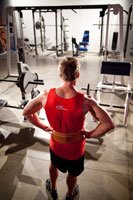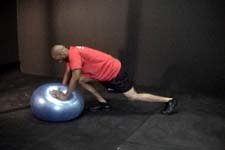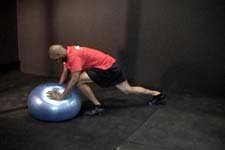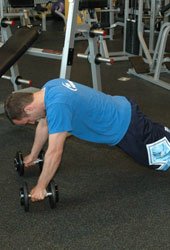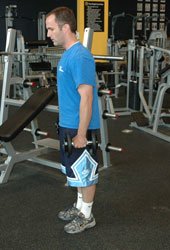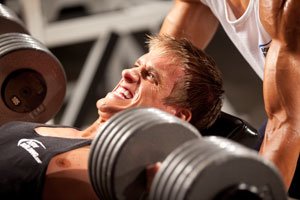
TOPIC: What Is The Best Intermediate Split-Training Routine For Gaining Mass?

The Question:
You have finally built enough strength in your muscles to move on to a more intermediate program to push yourself to a new level of growth.
What is the best intermediate split-training routine for gaining mass?
What are the differences between a beginner, intermediate and advanced bodybuilding workout?
How long is the transition from beginner to intermediate, then intermediate to advanced?
Bonus Question: Do you consider yourself a beginner, intermediate, or advanced bodybuilder?
Show off your knowledge to the world!
The Winners:
- soundcheck129 View Profile
- mrkdrt View Profile
Prizes:
- 1st place - 75 in store credit.
- 2nd place - 50 in store credit.

1st Place - soundcheck129
View This Author's BodySpace Here.

You have finally built enough strength in your muscles to move on to a more intermediate program to push yourself to a new level of growth.
Congratulations, you've made it - you're no longer a "newb." You've started to know what you're doing in the gym, and now people are looking at your arms because they actually have muscles and don't look like sticks. No time to party though - this is where the hard work begins.
Without being able to rely on "newb gains," making progress can be more difficult, so you're going to really have to challenge your body.
At this point, you'll probably want to adopt a body-part split, so you can give more attention to each muscle group and spur some real growth. But while you'll be doing a little more specialization here, don't neglect the big lifts that got you to this point - squats, bench press, and deadlifts. These are still phenomenal for gaining muscle and you won't want to stop doing them. And if you haven't been doing them up until this point... you'd better start now!

What Is The Best Intermediate Split-Training Routine For Gaining Mass?
At the intermediate level, a body-part split is pretty standard. Usually, this involves working just one or two muscle groups per day and hitting each of these groups just once each week. Additionally, because you can't really rely on "newb gains" anymore, I think it's important to add some cardio or conditioning work if you haven't been doing any up until this point. This will help keep your metabolism red hot and prevent unwanted fat gain, as you'll need to be eating a lot to progress.
I'm a fan of lifting heavy, so most of the rep schemes will be kept low. You may also want to incorporate some drop sets or supersets to kick up the intensity.
In a drop set, you perform the first set as normal, and then drop the weight and perform additional reps with no rest. In a superset, you alternate between sets of two (usually antagonistic, or opposite) exercises. These challenge your body and provide some great pumps.

Sunday: Legs
| TERMS YOU'LL NEED TO KNOW | |
|
- Leg Extension: 3 Sets Of 6-8 Reps
- Lying Leg Curl: 3 Sets Of 6-8 Reps
- Squats: 3 Sets Of 4-6 Reps
- Calf Raise: 3 Sets Of 6-8 Reps
- Stiff-Legged Deadlift: 3 Sets Of 4-6 Reps
- Leg Press: 3 Sets Of 4-6 Reps

Monday: Chest And Shoulders
- Dumbbell Shrugs: 3 Sets Of 6-8 Reps
- Decline Press: 3 Sets Of 6-8 Reps
- Military Press: 3 Sets Of 6-8 Reps
- Bench Press: 4 Sets Of 4-6 Reps
- Dumbbell Flyes: 3 Sets Of 6-8 Reps
- Lateral Raise: 3 Sets Of 6-8 Reps

Tuesday: Cardio
- 10 Minutes LISS
- 20 Minutes HIIT
- 10 Minutes LISS
 |
What Is LISS Cardio? LISS cardio is Low Intensity Steady State. This involves activites that have you at about 65-75% of your maximum heart rate for an extended period of time. For example, a slow jog or very fast walk for 45 minutes. |
 |
 |
||
- Or
- Deck Of Cards

Wednesday: Biceps And Triceps
- Skull Crushers: 3 Sets Of 6-8 Reps
- Chin-Ups: 3 Sets To Failure
- Overhead Triceps Extensions: 3 Sets Of 4-6 Reps
- Barbell Curls: 3 Sets Of 5-7 Reps
- Close-Grip Bench Press: 4 Sets Of 4-6 Reps
- Concentration Curls: 3 Sets Of 5-7 Reps

Thursday: Cardio
- 10 Minutes LISS
- 20 Minutes HIIT
- 10 Minutes LISS
OR
- Body Weight Circuit (repeat as desired):
- Squats: 1 Set Of 50 Reps
- Push-ups: 1 Set Of 25 Reps
- Mountain Climbers: 1 Set Of 25 Reps
- Bicycle Crunches: 1 Set Of 50 Reps
- Burpees: 1 Set Of 25 Reps
- Pull-ups: 1 Set Of 15 Reps

Friday: Back
- Lat Pull-down: 3 Sets Of 6-8 Reps
- Good Mornings: 3 Sets Of 6-8 Reps
- Deadlift: 3 Sets Of 4-6 Reps
- Chin-Ups: 3 Sets Of 4-6 Reps

How Do Beginner, Intermediate And Advanced Workouts Differ?
There are many differences between workouts depending on the experience level of the lifter, as some techniques are best left to those who have trained before and are stronger. For the most part, beginners should keep it as simple as possible and try not to worry about different rep schemes, body part splits, or excessive use of isolation exercises. Here's a basic outline of what typical workouts will look like based upon experience level.

Beginner:
- Full-Body Split
- Three Workout Days Per Week
- Heavy Reliance On The "Big Three:" Deadlifts, Squats, Bench Press
- One Or Two Rep Ranges
- Straight Sets Without More Advanced Techniques
- Usually No Added Cardio

Intermediate:
- Body-Part Or Push/Pull, Upper/Lower Split
- Three Or Four Workout Days Per Week
- Reliance On Compound Lifts But Also Isolation Exercises
- Multiple Rep Ranges
- Techniques Such As Supersets, Drop Sets
- Additional Cardio/Conditioning/Abdominal Days

Advanced:
- Body-Part Split Or Sport-Specific Training
- Four Or Five Workout Days Per Week
- Compound Lifts And Isolation Exercises, Plyometric Training
- Multiple Rep Ranges
- Advanced Techniques Such As Rest-Pause, Forced Reps, EDT, Wave Loading
- Additional Cardio/Conditioning/Abdominal Days
- Possible Days With Multiple Sessions

How Long Is The Transition From Beginner To Intermediate To Advanced?
The transition period varies depending on the individual. The harder one works, the quicker one will progress. Dedication makes a big difference, and one who makes bodybuilding a lifestyle rather than just an occasional hobby will see more impressive results.
Generally, though, one is no longer considered a beginner after about four months of training. Though this does not necessarily mean one is ready to take on advanced lifting techniques, the lifter should be ready to move on to slightly more complicated things - perhaps a body part split and some isolation exercises.
The transition from intermediate to advanced is much harder to define. At this point, the dedication factor becomes more relevant, and the amount of time spent training as well as improving oneself outside of the gym comes into play. One cannot progress from intermediate to advanced merely by lifting on occasion for a long period of time.
Becoming "advanced" requires additional knowledge - of training, nutrition, and of one's own body. The intermediate classification covers a lot of ground and a variety of experience levels, as the difference between a beginner and advanced lifter is vast.
To become an advanced lifter can take years of effort beyond the intermediate level. In my opinion, you can't really be an advanced bodybuilder unless you make it a central part of your life and a top priority. An advanced lifter generally understands exercise science and may be considering competition.

Do You Consider Yourself A Beginner, Intermediate, Or Advanced Bodybuilder?
I'd have to consider myself an intermediate bodybuilder. While I've put in enough time and energy to progress beyond the beginner level, I am nowhere near the advanced level. At this point, I don't have the desire to make bodybuilding my entire lifestyle, though I have a lot of respect for those that do.
I'm not sure whether I will ever reach the advanced level, but there is plenty of room to operate at the intermediate level, so I won't have to worry about progress coming to a halt unless I take things up to the next level.
I think that advanced bodybuilders have loftier, more complex goals than the average person, and I'm not ready to dedicate my entire life to achieving those kinds of goals at this time.

2nd Place - mrkdrt
View This Author's BodySpace Here.

You have finally built enough strength in your muscles to move on to a more intermediate program to push yourself to a new level of growth.
You're not a beginner anymore. You got your form down to a science. You've made some gains in strength and size. Now that you're past the beginner level of bodybuilding, you're ready to take your training to a whole new level.

What Is The Best Intermediate Split-Training Routine For Gaining Mass?
To maximize hypertrophy, frequency, intensity and volume are key factors. In this split you will want to maintain adequate frequency, while keeping intensity and volume high. Of course, recovery plays a key role in the volume and intensity of your training sessions.
Often in beginner workout programs, muscle groups are exercised each workout, usually 3 times a week. In this intermediate level split, an Upper/Lower split; muscle groups will be worked twice a week, with at least 2 days rest for Upper and Lower muscle groups. This split will have adequate frequency, while simultaneously allowing greater intensity and recovery.
Here's how you can set up your Upper/Lower training split:
- Monday - Upper A
- Tuesday - Lower A
- Wednesday - Rest/Cardio
- Thursday - Upper B
- Friday - Lower B
- Saturday - Rest/Cardio
- Sunday - Rest

Upper A
- Bench Press: 3 Sets Of 8-12 Reps
- Pull-ups: 3 Sets Of 8-12 Reps
- Barbell Shoulder Press: 3 Sets Of 8-12 Reps
- Dumbbell Shrugs: 4 Sets Of 6-10 Reps
- Dips: 4 Sets Of 6-10 Reps
- Concentration Curls: 4 Sets Of 6-10 Reps

Lower A
- Squats: 3 Sets Of 8-12 Reps
- Romanian Deadlifts: 3 Sets Of 8-12 Reps
- Donkey Calf Raises: 4 Sets Of 6-10 Reps

Upper B
- Dumbbell Incline Press: 3 Sets Of 8-12 Reps
- Bent-Over Barbell Rows: 3 Sets Of 8-12 Reps
- Dumbbell Shoulder Press: 3 Sets Of 8-12 Reps
- Barbell Shrugs: 4 Sets Of 6-10 Reps
- Close-Grip Bench Press: 4 Sets Of 6-10 Reps
- EZ-Bar Curls: 4 Sets Of 6-10 Reps

Lower B
- Leg Press: 3 Sets Of 8-12 Reps
- Deadlifts: 3 Sets Of 8-12 Reps
- Seated Calf Raises: 4 Sets Of 6-10 Reps
I recommend working the smaller muscle groups and isolation type exercises at the end of your workouts. Tiring these muscle groups out before compound lifts can weaken your performance for optimal hypertrophy training.
If have lagging body parts, you can compensate by training these muscle groups at an increased volume. As weeks go on you can further increase your volume if you'd like. To increase intensity, you may want to bump weights along your training sessions, and reduce rest time between sets. You may also consider incorporating techniques such as supersets, cheating reps, partial reps or negative reps.
With the goal being mass gain, I would keep the cardio lighter, to minimize catabolism. Basically you can do anything here, like jogging, walking, playing sports, anything within the aerobic range. Keeping your nutrition and supplementation on point for this program will also help a great deal.

How Do Beginner, Intermediate And Advanced Workouts Differ?
Beginner workouts focus a lot on overall growth of muscle groups. In intermediate levels, athletes start to focus on lagging body parts or muscle imbalances to sculpt their physique. Once in the advanced stage, athletes may be real close to their competitive or cosmetic goals. So workouts may be geared to making fine adjustments to their physique.
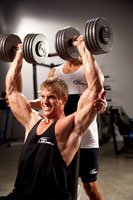
 Click To Enlarge.
Click To Enlarge. Intermediate Athletes Start To Focus On
Lagging Body Parts To Sculpt Their Physique.
Compounds lifts make up the majority of beginner workouts. Beginners respond well to these exercises and can have great gains with these alone. In intermediate levels and above, more isolation type exercises may be used to being up lagging or weaker muscle groups to improve their body shape.
As you're level of bodybuilding advances, the amount of hypertrophy you get out of your workouts will usually decrease. Of course, after your newbie gains, intermediate training techniques can still be quite fruitful for you. But in the advanced level it takes great effort to induce hypertrophy, and more unorthodox and difficult training techniques may be used.
Beginners take more rest days because their bodies aren't yet used to the stress of the training, and can't train as often. As you advance, your body recovers faster, can handle the stress better and you can train more than you could before.

How Long Is The Transition From Beginner To Intermediate To Advanced?
The time between bodybuilding levels depends on you, the athlete. Your genetics, nutrition, training, how your body responds to stimuli, supplementation can all have profound effect on how quickly, or slowly, you advance to the next level of bodybuilding.
If your newbie gains have run out, you're confident in your form and training skill, your knowledge of proper nutrition and supplementation is sharp, then hey, you're no longer a beginner. You've made it to the intermediate level. This doesn't always take years to achieve.
Now, I would say though that the transition from intermediate to advanced bodybuilding is longer than that of beginner to intermediate. Intermediate bodybuilders take lots of time to further meet their goals and create their desired physique.
This transition can be short or can take years and you can still push towards your goal with intermediate bodybuilding techniques. But hey, if you're confident in your skill or you've hit a plateau, you can always try out more advanced bodybuilding techniques.

Do You Consider Yourself A Beginner, Intermediate, Or Advanced Bodybuilder?
I consider myself an intermediate bodybuilder. I know my stuff, and put it to use well, but I can't say I've earned enough "stripes" yet to be called an advanced bodybuilder. My body still responds well to intermediate training techniques, and hypertrophy and fixing muscle imbalances are my main issues right now. Advanced goals of fine-tuning my physique are far in my horizon.
Cheers
mrkdrt
References:



